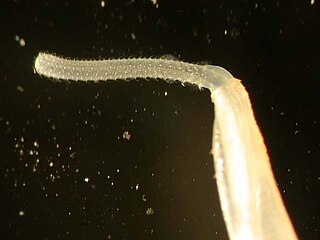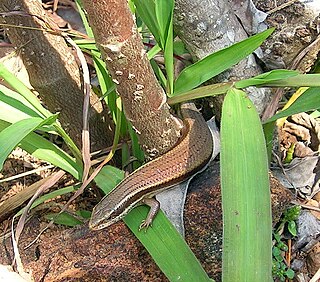
Parvoscincus is a genus of skinks, lizards in the family Scincidae. The genus is endemic to the Philippines.

The genus Sphenomorphus – vernacularly also known as the common skinks – currently serves as a "wastebin taxon" for numerous skinks. While most or all species presently placed here are probably rather close relatives, the genus as presently delimited is likely to be not monophyletic and is in need of review. Some species in this genus have been moved to Pinoyscincus.

Sphenomorphus indicus is a species of skink.

Sphenomorphus maculatus, the spotted forest skink, maculated forest skink or stream-side skink is a species of skink found in China, South Asia and Southeast Asia.

Palaeacanthocephala is a class within the phylum Acanthocephala. The adults of these parasitic platyzoans feed mainly on fish, aquatic birds and mammals. This order is characterized by the presence of lateral longitudinal lacunar canals and a double-walled proboscis receptacle. The nuclei of the hypodermis are fragmented and the males have two to seven cement glands, unlike their relatives the Archiacanthocephala, which always have eight.

Lygosominae is the largest subfamily of skinks in the family Scincidae. The subfamily can be divided into a number of genus groups. If the rarely used taxonomic rank of infrafamily is employed, the genus groups would be designated as such, but such a move would require a formal description according to the ICZN standards.
Petronella Johanna Nelly de Rooij was a Dutch zoologist and herpetologist.

Lieven Ferdinand de Beaufort was a Dutch biologist who, in 1903, participated in the North New Guinea Expedition. In the 1920s he was director of the Zoological Museum of Artis in Amsterdam and later zoogeography professor at the University of Amsterdam.

Parvoscincus leucospilos, the white-spotted sphenomorphus, is a species of skink endemic to the Philippines. It is found between 300 and 1,200 m above sea levels in the forests of central and southern Sierra Madre Mountain Range of Luzon Island. This skink hides under rocks or in debris in the banks of streams and rivers. When threatened by predators, such as snakes, it may dive and stay under water for a long time.

Otosaurus cumingii, commonly called Cuming's sphenomorphus or the Luzon giant forest skink, is a species of skink, a lizard in the family Scincidae. The species is endemic to the Philippines.
Sphenomorphus maindroni is a species of lizard in the family Scincidae. The species was originally described by Sauvage in 1879. According to the Catalogue of Life, the species Sphenomorphus maindroni does not have known subspecies.
Pinoyscincus is a genus of skinks, lizards in the family Scincidae. All species in the genus are endemic to the Philippines. Species in this genus were previously assigned to the genus Sphenomorphus.
Sphenomorphus darlingtoni is a species of skink, a lizard in the family Scincidae. The species is endemic to Papua New Guinea.
Sphenomorphus leptofasciatus is a species of skink. It is found in Papua New Guinea.

Sphenomorphinae is a large subfamily of skinks, lizards within the family Scincidae. The genera in this subfamily were previously found to belong to the Sphenomorphus group in the large subfamily Lygosominae.
Lepidodactylus aignanus is a species of gecko. It is endemic to Misima Island in the Louisiade Archipelago, Papua New Guinea.
The pointed-headed sphenomorphus is a species of skink found in the Philippines.
Sphenomorphus cranei, also known commonly as Crane’s skink and Crane's forest skink, is a species of lizard in the family Scincidae. The species is endemic to the Solomon Islands.
Sphenomorphus stellatus, the Perak forest skink or starry forest skink, is a species of skink found in Malaysia.
Sphenomorphus tersus, the Nakhon Si-Thammarat forest skink or Thai forest skink, is a species of skink found in Thailand and Malaysia.









